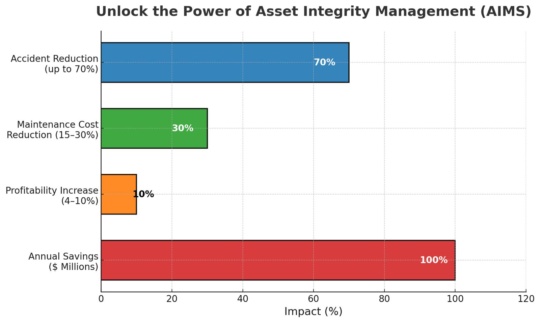Introduction: Why Asset Integrity Management is a Game-Changer in Oil, Gas, and Renewables
In today’s energy landscape—whether in oil and gas plants, petrochemical facilities, offshore platforms, gas processing plants, or even in renewable energy projects—Asset Integrity Management Systems (AIMS) are no longer optional; they are essential for operational excellence.
Properly implemented asset integrity programs ensure that critical equipment and infrastructure remain safe, reliable, and profitable throughout their lifecycle. The global importance of integrity management is reflected in the numbers: the Asset Integrity Management market reached $22.4 billion in 2023 and is projected to grow to $34.1 billion by 2032 (4.8% CAGR) [Source: MetaStat Insight].
Organizations today cannot afford the risks, unplanned downtime, or financial losses associated with asset failures. Asset Integrity Management Solutions protect your people, your environment—and your bottom line.

Unlocking Safety, Reliability, and Profitability through Asset Integrity Management Systems (AIMS)
The Numbers: Risk and Accident Reduction Through Asset Integrity Management
The statistics tell a powerful story about the benefits of adopting a robust Asset Integrity Management strategy.
According to the International Association of Oil & Gas Producers (IOGP):
•The global fatal accident rate fell to 0.82 fatalities per 100 million work-hours in 2023—a 36% reduction compared to 2022 [Source: IOGP Safety Report 2023].
•The total recordable incident rate (TRIR) dropped to 0.84 per million hours, a 7% decrease year-over-year.
•The lost-time injury rate (LTIR) declined to 0.24 per million hours, a 14% improvement.
What’s driving these improvements?
The answer lies in stronger integrity management programs, including:
•Proactive inspection planning
•Corrosion control programs
•Risk-Based Inspection (RBI) strategies
Studies published by the Association for Materials Protection and Performance (AMPP) confirm that corrosion management programs alone can significantly reduce leak incidents, unscheduled maintenance, and environmental accidents [Source: AMPP Report 2022].
Bottom line: Implementing an effective Asset Integrity Management System can reduce accidents by 50% to 70% over time in mature operations.
⸻
The Financial Impact: Saving Millions Through Asset Integrity Solutions
Asset Integrity Management doesn’t just enhance safety—it delivers serious cost savings.
According to McKinsey & Company:
•Companies with strong asset integrity initiatives achieve 4–10% higher profitability.
•Maintenance costs can be reduced by 15–30% through optimized inspection programs and predictive maintenance technologies [Source: McKinsey Maintenance 4.0 Study].
Moreover:
•Average unscheduled downtime costs approximately $125,000 per hour [Source: Vanson Bourne Survey].
•In oil and gas plants, downtime costs can escalate to $220,000 per hour, amounting to $84 million annually per facility [Source: GE Digital Study].
With Asset Integrity Management Systems, operators can:
•Increase asset uptime and availability
•Extend the operational life of critical assets by 20–40%
•Reduce insurance premiums through improved safety performance
•Maximize production margins by avoiding costly shutdowns
In one refinery case study, avoiding a single major unplanned shutdown saved $12 million in just one peak production month [Source: McKinsey Operations Insights].
⸻
Asset Integrity Management for Renewable Energy
The principles of asset integrity management are just as critical for renewable energy projects, including offshore wind farms, solar PV plants, and hydrogen infrastructure.
For instance, in offshore wind:
•Blade failure rates can be minimized through proactive inspection and predictive maintenance.
•Foundation and substructure monitoring ensures operational longevity and reduces the risk of catastrophic failures.
According to the DNV Energy Transition Outlook:
•40% of energy professionals globally reported that digital asset integrity tools have already improved safety in renewable energy operations.
As global investment in renewables accelerates, integrity management programs will define operational success and long-term asset profitability.
⸻
The Solution: RBLX™ – Advanced Asset Integrity Management Software
At LifeTech Engineering, we recognize that today’s operators demand more than spreadsheets and outdated inspection routines.
You need a modern, powerful, and integrated Asset Integrity Management solution.
That’s why we developed RBLX™ — our next-generation AIM software, trusted by leaders in oil, gas, and renewables.
RBLX™ delivers:
•Comprehensive support for Risk-Based Inspection (RBI), Inspection Data Management Systems (IDMS), Fitness-for-Service (FFS), Corrosion Control Documents (CCD), and Integrity Operating Windows (IOWs).
•Predictive analytics to detect and prevent failures early.
•Real-time dashboards for complete visibility into asset health.
•Seamless integration with enterprise CMMS platforms like SAP and IBM Maximo.
•Full compliance with API 580, API 581, API 571, API 579, and other industry standards.
With RBLX™, you’re not just managing assets—you’re optimizing performance, safety, and profitability.
⸻
Conclusion: Asset Integrity Is an Investment in Your Future
Whether you operate oil and gas infrastructure or manage renewable energy assets, adopting a world-class Asset Integrity Management System is one of the smartest investments you can make.
•Reduce accidents by up to 70%
•Cut maintenance costs by 15–30%
•Boost profitability by 4–10%
•Save millions annually by minimizing downtime
The future belongs to companies that protect their people, their assets, and their reputation.
Discover how RBLX™ can elevate your asset integrity journey.
Contact LifeTech Engineering to schedule a demo today.
⸻
Refrences:
•International Association of Oil & Gas Producers (IOGP), Safety Performance Indicators Report 2023
•McKinsey & Company, Maintenance 4.0 Study 2022
•AMPP (formerly NACE), 2022 Corrosion Management Benchmark Report
•DNV, Energy Transition Outlook 2023
•Vanson Bourne Industrial Downtime Survey 2022
•GE Digital, The Cost of Downtime Report